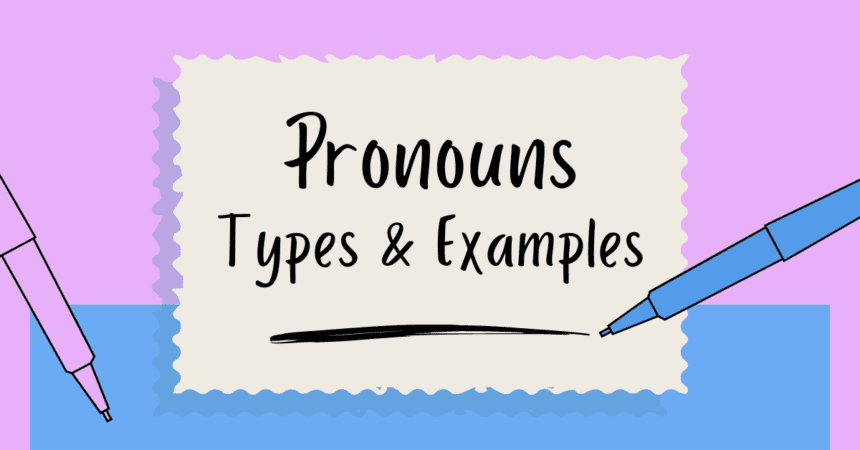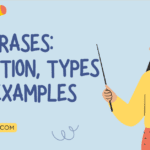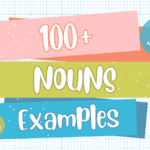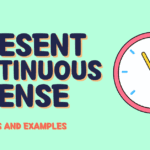A pronoun is a word that is used to refer to a person, place, thing, or idea instead of using their name or a noun. Pronouns can take the place of a noun in a sentence and can be used to avoid repeating the same noun multiple times.
Examples of Pronouns
Here are some examples of sentences using pronouns:
- I went to the store to buy some milk. (The pronoun “I” is used instead of repeating the name of the person speaking.)
- She gave me her phone number. (The pronoun “she” is used to refer to a specific person, and the pronoun “her” is used to show possession.)
- These cookies are mine. (The pronoun “these” is used to point out specific cookies, and the pronoun “mine” shows possession.)
- We enjoyed ourselves at the party. (The pronoun “ourselves” is used as the subject and object of the verb “enjoyed” and refers to the people speaking.)
- They helped each other with their homework. (The pronoun “they” is used to refer to two or more people, and the pronoun “each other” is used to show that they were acting reciprocally.)
Why do we use Pronouns?
Pronouns are used for a variety of reasons, including:
- To avoid repeating the same noun: Pronouns can be used to avoid repeating the same noun multiple times within a sentence or paragraph, which can make writing or speaking more concise and easier to understand. For example: “My sister and I went to the park. She played on the swings while I played on the slide.” In this sentence, the pronoun “she” is used to refer to the sister, and the pronoun “I” is used to refer to the person speaking, avoiding the need to repeat the nouns “sister” and “I.”
- To add variety to language: Using pronouns can help to add variety to language and make it more interesting. For example, using different personal pronouns (such as “I,” “you,” “he,” “she,” “it,” “we,” and “they”) can help to create a more engaging and dynamic text.
- To refer to people or things: Pronouns are often used to refer to people or things that have already been mentioned or are known to the listener or reader. For example: “I saw John at the store. He was looking for a new shirt.” In this sentence, the pronoun “he” is used to refer to John, who has already been mentioned in the sentence.
- To show possession or ownership: Possessive pronouns (such as “mine,” “yours,” “hers,” and “theirs”) can be used to show possession or ownership of something. For example: “This book is mine.” In this sentence, the possessive pronoun “mine” shows that the person speaking owns the book.
- To point out specific people or things: Demonstrative pronouns (such as “this,” “that,” “these,” and “those”) can be used to point out specific people or things. For example: “This is my favorite book.” In this sentence, the demonstrative pronoun “this” is used to point out a specific book.
Types of Pronouns
There are several types of pronouns in the English language, including:
Personal pronouns
Personal pronouns are words that replace nouns in a sentence and refer to people, places, or things. They can be used to indicate the person speaking (first person), the person being spoken to (second person), or the person or thing being spoken about (third person).
Here are some personal pronouns:
- First person: I, me, my, mine, we, us, our, ours
- Second person: you, your, yours
- Third person: he, him, his, she, her, hers, it, its, they, them, their, theirs
Examples of Personal Pronouns
- First person:
- I am going to the store. (The speaker is the one going to the store.)
- We are having a party. (The speaker and others are having a party.)
- Second person:
- You are coming to the party, right? (The speaker is addressing the person being spoken to and asking if they are coming to the party.)
- Third person:
- She is going to the store. (The speaker is talking about someone else going to the store.)
- They are having a party. (The speaker is talking about others having a party.)
Personal pronouns can be used to make sentences more concise and clear, as well as to show respect or politeness. For example, using “you” instead of a person’s name can be more formal and polite, while using “I” can be more casual and friendly. It’s important to choose the appropriate personal pronoun based on the context and the relationship between the speaker and the person being spoken to.
Possessive pronouns
Possessive pronouns are words that show ownership or possession. They can be used to indicate that something belongs to someone or something. There are several possessive pronouns in English, including:
- mine – shows possession by the speaker
- yours – shows possession by the person being spoken to
- his – shows possession by a male person or animal
- her – shows possession by a female person or animal
- its – shows possession by an inanimate object or animal
- ours – shows possession by a group including the speaker
- theirs – shows possession by a group not including the speaker
Examples of Possessive Pronouns
Here are some examples of possessive pronouns being used in sentences:
- That book is mine. (The speaker is indicating that they own the book.)
- Is this pen yours? (The speaker is asking if the person being spoken to owns the pen.)
- His car is parked in the driveway. (The speaker is indicating that a male person owns the car.)
- Her dress is red. (The speaker is indicating that a female person owns the red dress.)
- The cat knocked over its water bowl. (The speaker is indicating that the cat owns the water bowl.)
- Our dog is very friendly. (The speaker is indicating that they and possibly others own the dog.)
- Their house is very large. (The speaker is indicating that a group not including the speaker owns the house.)

Relative pronouns
Relative pronouns are words that introduce a clause in a sentence and refer to a noun or pronoun previously mentioned. They can be used to provide more information about the noun or pronoun and to connect the clause to the rest of the sentence. Here are some examples of relative pronouns:
- who, whom, whose (refer to people)
- that, which (refer to things)
- where (refers to a place)
- when (refers to a time)
Examples of Relative Pronouns
Relative pronouns can be used to join clauses in a sentence and create complex sentences. Here are some examples:
- The man who was standing in line is my uncle. (The clause “who was standing in line” provides more information about the noun “man” and is connected to the rest of the sentence with the relative pronoun “who.”)
- I saw the movie that you recommended. (The clause “that you recommended” provides more information about the noun “movie” and is connected to the rest of the sentence with the relative pronoun “that.”)
- The house where I grew up is on the other side of town. (The clause “where I grew up” provides more information about the noun “house” and is connected to the rest of the sentence with the relative pronoun “where.”)
Relative pronouns can also be omitted if they are not necessary for the meaning of the sentence. For example:
- The man (who) I saw at the store is my uncle.
- I saw the movie (that) you recommended.
- The house (where) I grew up is on the other side of town.
In these examples, the relative pronouns are enclosed in parentheses because they can be left out without changing the meaning of the sentence. However, including the relative pronouns can make the sentence clearer and more concise.
Reflexive pronouns
Reflexive pronouns are words that reflect back to the subject of the clause or sentence and indicate that the subject is performing the action on itself. They can be used to add emphasis or to clarify the subject of the clause or sentence. Here are some examples of reflexive pronouns:
- myself
- yourself
- himself
- herself
- itself
- ourselves
- yourselves
- themselves
Examples of Reflexive Pronouns
Reflexive pronouns are used when the subject of the clause or sentence is also the object of the verb. For example:
- I hurt myself. (The subject of the sentence is “I,” and the object of the verb “hurt” is “myself.” “Myself” reflects back to the subject “I” and indicates that the subject is performing the action on itself.)
- She saw herself in the mirror. (The subject of the sentence is “she,” and the object of the verb “saw” is “herself.” “Herself” reflects back to the subject “she” and indicates that the subject is performing the action on itself.)
- We enjoyed ourselves at the party. (The subject of the sentence is “we,” and the object of the verb “enjoyed” is “ourselves.” “Ourselves” reflects back to the subject “we” and indicates that the subject is performing the action on itself.)
Reflexive pronouns can also be used for emphasis, to add clarity to the sentence, or to avoid repetition. For example:
- I did it myself. (The reflexive pronoun “myself” is used for emphasis to indicate that the speaker did the task without help.)
- She gave the gift to herself. (The reflexive pronoun “herself” is used to clarify that the gift was given to the subject “she” and not to someone else.)
- We prepared the meal ourselves. (The reflexive pronoun “ourselves” is used to avoid repeating the subject “we” and to indicate that the subject did the task without help.)
It’s important to use reflexive pronouns correctly and appropriately in a sentence to ensure that the meaning is clear and accurate.
Indefinite pronouns
Indefinite pronouns are words that refer to people, places, or things without specifying exactly who or what they are. They can be used to indicate a general or unknown person, place, or thing, or to refer to a group of people or things. Here are some examples of indefinite pronouns:
- all, another, any, both, each, either, everybody, everyone, everything, few, many, neither, nobody, none, one, several, some, somebody, someone, something, such
Examples of Indefinite Pronouns
Indefinite pronouns can be singular or plural, depending on the context in which they are used. Here are some examples of indefinite pronouns in different sentences:
- Each of the students handed in their homework. (The indefinite pronoun “each” is singular and refers to a group of students, but it implies that the students are acting individually.)
- Many of the books are missing from the shelf. (The indefinite pronoun “many” is plural and refers to a group of books.)
Indefinite pronouns can also be used to refer to an unknown or unspecified person or thing. For example:
- Anyone can join the club. (The indefinite pronoun “anyone” refers to any person, regardless of who they are.)
- Something is wrong with the car. (The indefinite pronoun “something” refers to an unknown thing that is causing a problem with the car.)
It’s important to use indefinite pronouns correctly and appropriately in a sentence to ensure that the meaning is clear and accurate.
Demonstrative pronouns
Demonstrative pronouns are words that point to or indicate a specific person, place, or thing. They can be used to identify the noun or pronoun being referred to or to specify its location in relation to the speaker. Here are some examples of demonstrative pronouns:
- this
- that
- these
- those
Examples of Demonstrative Pronouns
Demonstrative pronouns can be singular or plural, and they can be used to indicate proximity (near or close to the speaker) or distance (far from the speaker). Here are some examples of demonstrative pronouns in different sentences:
- Singular: This is my book. (The demonstrative pronoun “this” is singular and refers to a specific object that is near the speaker.)
- Plural: Those are my books. (The demonstrative pronoun “those” is plural and refers to a specific group of objects that are far from the speaker.)
- Proximity: This is the best movie I’ve ever seen. (The demonstrative pronoun “this” refers to a specific object that is near the speaker and is being compared to other movies.)
- Distance: That is the best movie I’ve ever seen. (The demonstrative pronoun “that” refers to a specific object that is far from the speaker and is being compared to other movies.)
Demonstrative pronouns can also be used to indicate a specific noun or pronoun that has already been mentioned. For example:
- I saw the movie, and this is my review. (The demonstrative pronoun “this” refers to the noun “review,” which has already been mentioned.)
- I saw two movies, and those were both great. (The demonstrative pronoun “those” refers to the noun “movies,” which have already been mentioned.)
It’s important to use demonstrative pronouns correctly and appropriately in a sentence to ensure that the meaning is clear and accurate.
Interrogative pronouns
Interrogative pronouns are words that are used to ask questions. They are used to ask for information or to clarify a point. Here are some examples of interrogative pronouns:
- who
- whom
- whose
- what
- which
Examples of Interrogative Pronouns
Interrogative pronouns can be used to ask questions about people, places, or things. Here are some examples:
- Who is coming to the party? (The interrogative pronoun “who” is used to ask about a person.)
- Whose jacket is this? (The interrogative pronoun “whose” is used to ask about possession or ownership.)
- What do you want to do tonight? (The interrogative pronoun “what” is used to ask about a thing or an action.)
- Which movie do you want to watch? (The interrogative pronoun “which” is used to ask about a specific person, place, or thing within a group or a choice.)
Interrogative pronouns can be used at the beginning of a question or as part of the question. For example:
- Who is coming to the party? What do you want to do tonight? Which movie do you want to watch?
- Is this your jacket? (The interrogative pronoun “this” is used as part of the question to ask about possession or ownership.)
It’s important to use interrogative pronouns correctly and appropriately in a sentence to ensure that the meaning is clear and accurate.
Intensive pronouns
Intensive pronouns are words that are used to add emphasis to a noun or pronoun in a sentence. They are also known as reflexive pronouns, but they are used differently in a sentence. Intensive pronouns are not essential to the meaning of the sentence and can be removed without changing the basic meaning of the sentence. Here are some examples of intensive pronouns:
- myself, yourself, himself, herself, itself, ourselves, yourselves, themselves
Examples of Intensive Pronouns
Intensive pronouns are used to add emphasis to the noun or pronoun that they refer to, to indicate that the speaker or subject is performing the action, or to clarify the subject of the clause or sentence. Here are some examples:
- I myself made the cake. (The intensive pronoun “myself” is used to add emphasis to the subject “I” and to indicate that the speaker made the cake.)
- She herself saw the movie. (The intensive pronoun “herself” is used to add emphasis to the subject “she” and to indicate that the subject saw the movie.)
- We ourselves enjoyed the party. (The intensive pronoun “ourselves” is used to add emphasis to the subject “we” and to indicate that the subject enjoyed the party.)
It’s important to use intensive pronouns correctly and appropriately in a sentence to ensure that the meaning is clear and accurate.
Reciprocal pronouns
Reciprocal pronouns are words that indicate mutual or reciprocal actions or relationships. They are used to show that two or more people or things are interacting or affecting each other in some way. Here are the two reciprocal pronouns:
- each other
- one another
Examples of Reciprocal Pronouns
Reciprocal pronouns are used to indicate that two or more people or things are performing an action on each other or have a reciprocal relationship. Here are some examples:
- My parents and I love each other. (The reciprocal pronoun “each other” indicates that the subject “my parents” and the subject “I” have a reciprocal relationship of love.)
- The siblings argue with one another. (The reciprocal pronoun “one another” indicates that the subject “the siblings” are performing the action of arguing on each other.)
- The friends help each other with their homework. (The reciprocal pronoun “each other” indicates that the subject “the friends” are performing the action of helping on each other.)
It’s important to use reciprocal pronouns correctly and appropriately in a sentence to ensure that the meaning is clear and accurate.

How to reach pronoun agreement?
Pronoun agreement refers to the use of pronouns that are consistent with the nouns or pronouns they refer to in a sentence. In order for a pronoun to agree with its antecedent (the noun or pronoun it refers to), it should be the same in number, gender, and person. Here are some tips for ensuring pronoun agreement:
- Make sure the pronoun and its antecedent are the same in number. If the antecedent is singular, the pronoun should be singular, and if the antecedent is plural, the pronoun should be plural. For example:
Correct: “The cat is sleeping. It is snoring loudly.” (The pronoun “it” is singular and agrees with the antecedent “cat,” which is also singular.)
Incorrect: “The cat is sleeping. They are snoring loudly.” (The pronoun “they” is plural and does not agree with the antecedent “cat,” which is singular.)
- Make sure the pronoun and its antecedent are the same in gender. If the antecedent is masculine or feminine, the pronoun should be masculine or feminine, respectively. For example:
Correct: “The actor was happy with his performance.” (The pronoun “his” is masculine and agrees with the antecedent “actor,” which is also masculine.)
Incorrect: “The actress was happy with his performance.” (The pronoun “his” is masculine and does not agree with the antecedent “actress,” which is feminine.)
- Make sure the pronoun and its antecedent are the same in person. If the antecedent is first person (I, we), the pronoun should be first person, and if the antecedent is second person (you), the pronoun should be second person, etc. For example:
Correct: “I am going to the store. I need to buy some milk.” (The pronoun “I” is first person and agrees with the antecedent “I,” which is also first person.)
Incorrect: “She is going to the store. I need to buy some milk.” (The pronoun “I” is first person and does not agree with the antecedent “she,” which is third person.)
By following these tips and paying attention to the number, gender, and person of the antecedent and pronoun, you can ensure pronoun agreement in your sentences.
How to establish pronoun reference?
Pronoun reference refers to the way that pronouns in a sentence refer back to a specific noun or noun phrase. It is important to make sure that the pronoun reference is clear so that the reader or listener can understand who or what the pronoun is referring to.
For example, in the sentence “John went to the store and he bought milk,” the pronoun “he” refers back to the noun “John.” In this case, the pronoun reference is clear.
However, in the sentence “John went to the store and he gave the milk to his sister,” the pronoun “his” could potentially refer either to John or to someone else mentioned earlier in the conversation. In this case, the pronoun reference is not clear and could cause confusion for the reader or listener.
To avoid confusion, it is important to make sure that pronoun reference is clear and consistent throughout a sentence or conversation. This can be achieved by using explicit nouns or by rephrasing the sentence to eliminate ambiguity.
Here are some tips for establishing pronoun reference:
- Make sure the pronoun and its antecedent are close together in the sentence. This can help to clarify the reference of the pronoun and avoid confusion. For example:
Correct: “The cat chased its tail.” (The pronoun “its” is close to the antecedent “cat” and clearly refers to it.)
Incorrect: “The cat chased its tail around the room. It was very funny to watch.” (The pronoun “it” is far from the antecedent “cat” and may be confusing to the reader.)
- Use specific nouns and pronouns as antecedents. This can help to avoid ambiguity and ensure that the reference of the pronoun is clear. For example:
Correct: “My sister is taller than me.” (The pronoun “me” refers to the specific noun “sister” and is not ambiguous.)
Incorrect: “Someone is taller than me.” (The pronoun “me” does not have a specific antecedent and may be ambiguous.)
- Avoid using pronouns that could refer to more than one noun or pronoun. This can help to avoid confusion and ensure that the reference to the pronoun is clear. For example:
Incorrect: “Take the laptop from the car and fix it. (The pronoun “it” could refer to either “laptop” or “car,” which is ambiguous.)
Correct: Take the laptop from the car and fix the laptop.
Here are some more tips for establishing pronoun reference:
- Use explicit nouns: Whenever possible, use explicit nouns instead of pronouns to avoid confusion. For example, instead of saying “She gave it to him,” you could say “Jane gave the book to John.”
- Repeat the noun: If you do need to use a pronoun, consider repeating the noun that it refers to. For example, you could say “John went to the store and he himself bought milk.” This helps to make the pronoun reference clear.
- Use context: Use the context of the conversation or the surrounding text to help establish pronoun reference. For example, if you know that John is the only person being discussed in the conversation, it will be clear that “he” refers to John.
- Use modifying phrases: Modifying phrases can help to establish the noun that a pronoun refers to. For example, instead of saying “She gave it to him,” you could say “She gave the book to her brother.”
- Avoid using ambiguous pronouns: Some pronouns, such as “it” and “they,” can be ambiguous and may not clearly refer to a specific noun. Whenever possible, try to use more specific pronouns, such as “he,” “she,” or “them,” to avoid confusion.
- Use clear pronoun-antecedent relationships: Make sure that the pronoun you use agrees in number and gender with the noun it is referring to. This helps to clarify which noun the pronoun is referring to.
- Avoid pronoun overload: Try to avoid using too many pronouns in a single sentence or paragraph, as this can make it difficult for readers to understand which nouns the pronouns are referring to.
By following these tips and paying attention to the relationship between the pronoun and its antecedent, you can establish clear and unambiguous pronoun reference in your sentences.








